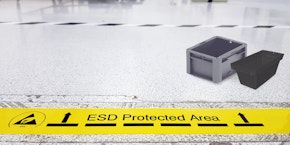When should you use electrostatic discharge containers in the warehouse?

Have you ever walked over carpet in a department store, and then got shocked when you touched an object? If so, you have become the victim of an electrostatic discharge (ESD). These discharges are usually harmless to you, unless flammable gases and liquids exist in your area. This could be the case for example, at petrol stations or in industrial companies. A little tip: at petrol stations, it is advisable to briefly touch the body or petrol pump before starting the refueling process in order to discharge yourself statically.
ESD can cause damage to electronic components
Electrical, electronic, optoelectronic, and numerous electromechanical components can be destroyed or damaged by electrostatic discharges. ESD is one of the most common causes of failure, particularly in the case of integrated circuits based on semiconductors. There is even more fear of the latent damage, in which the component just passes the quality test, but fails after a short lifetime. This creates issues, namely expensive service costs.
Avoiding ESD damage
All ESD-sensitive components and assemblies (e.g. computer components) must be handled, packaged, and stored in an environment protected against electrostatic discharge (Electrostatic Protected Area, EPA). ESD workstations and ESD-protected areas dissipate existing electrostatic charges in a controlled manner into the ground and prevent charges generated by frictional electricity from occuring. This can be achieved with conductive work surfaces and flooring; conductive antistatic tapes; appropriate furniture; proper clothing including conductive shoes; , ionized ambient air; and grounding of all components. Two basic principles are used to protect against electrostatic discharge:
Charging people, objects, and components should be avoided. This is done by diverting the current and grounding the body.
In addition, rapid discharges must be avoided and the existing electrical charges spread over a large electrical resistance.
Selection of suitable ESD containers
Containers for the storage and transport of components are often made of polypropylene (PP). PP has many good properties. Among other things, PP can be used as a current insulator because it is practically non-conductive. Nevertheless, electrical charges can be generated on a polypropylene surface. Rubbing a garment against the PP surface or moving a container over slides, conveyor tracks, etc. can create relatively high tension. There are various ways to reduce these tensions. This can be achieved by an air flow of ionized air. Depending on the application, it may also make more sense to artificially increase the conductivity of the polypropylene itself.
Conductive or dissipative ESD containers
The material of the container can be modified to protect against ESD by two measures. On the one hand, the PP for the ESD containers is added by the addition of made of conductive soot particles. As a result, the material for the boxes turns black, the density increases, and the electrical resistance equates to approximately <105Ohm. The production of ESD containers made of electrically conductive PP for the storage and transport of electronic components is a little more expensive. This method requires additional effort in processing, since the material leads to a certain contamination of the equipment. In addition to higher cleaning costs, conductive PP is not recommended for use in clean rooms.
The second way to modify the PP from ESD containers is to increase the resistance to about 1011Ohm. Therefore, the material is no longer referred to as conductive, but as dissipative. This material variant is preferred by some companies because the current is not diverted suddenly, but "more gently" -- preventing damage to the sensitive electronic components. Dissipative material is available in several basic colors, and is also suitable for clean rooms. However, both types of material discussed here are not suitable for contact with food.
BITO has ESD Euro containers, ESD storage bins, ESD KLT containers, ESD stacking containers, ESD folding boxes, ESD boxes, ESD heavy-duty containers, ESD pallets, ESD shelves, ESD roller strips, ESD transport rollers, and much more.
